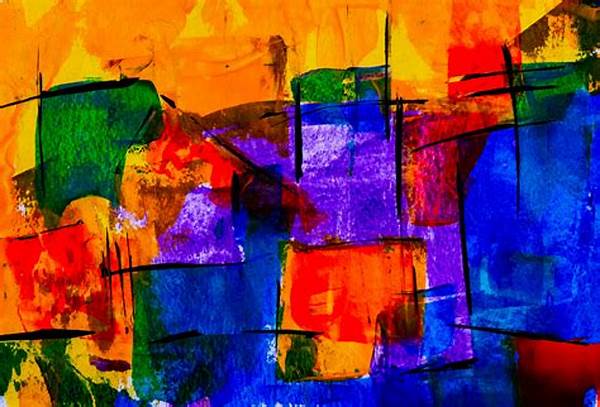Abstract Expressionism In Painting
A New Movement Takes Shape
Once upon a time, in the bustling city of New York, a group of painters dared to redefine the boundaries of art. This was a time when traditional styles no longer felt adequate to express the chaos and emotion of the modern world. Amidst this backdrop of transformation, a new artistic movement was born—Abstract Expressionism in painting. It was not merely a style but a philosophy, an emotional outpouring manifested on canvas.
Read Now : Artistic Innovation Through Influence Comprehension
The pioneers of Abstract Expressionism found solace and expression not in depicting the visible world but in embodying the world within. Through bold colors, sweeping gestures, and intense energy, they captured raw emotion, inviting viewers to a personal encounter with art. Painters like Jackson Pollock, with his iconic drip techniques, and Mark Rothko, known for his profound color fields, opened the door for the audience to walk into the unknown, where intuition and spontaneity reigned supreme.
This art form emerged as a reflection of post-war disillusionment and the complexities of human existence. Abstract Expressionism in painting became a means of confronting a new reality. It was a silent scream on canvas—a bold declaration that art need not conform to recognizable forms to be potent and profound. It was a rejection of precision and a celebration of freedom, a powerful reminder that art could be a personal journey as much as a public statement.
The Pioneers of Passion
In the heart of New York’s vibrant art scene, Abstract Expressionism in painting gathered momentum. Artists like Jackson Pollock, known for his “drip” technique, transformed canvases into vivid landscapes of emotion. Meanwhile, Mark Rothko’s ethereal color fields urged viewers to lose themselves in fields of color, searching for deeper meaning and connection.
Willem de Kooning, with his raw, visceral brushstrokes, captured the dynamic energy of human form and emotion. Lee Krasner, a powerful force herself, wove complex compositions that spoke of chaos and harmony. These artists, among others, challenged conventions, creating art that spoke directly to the soul.
The technique was secondary to the expression. It was about the physical act of painting—a dance with the medium, where each stroke was a note of a larger symphony. For the Abstract Expressionists, the canvas was not a space to fill with images, but a stage for an emotional performance.
The Stories Hidden in the Canvas
1. The Dance of Paint: Abstract Expressionism in painting was about movement—an artist’s dance with the canvas. With each brushstroke, Pollock’s passion unfolded, connecting the viewer to the rhythm of creation.
2. Colors of Emotion: Rothko’s large blocks of color were more than just paint; they were gateways to the soul, capturing the gamut of human emotions within the vastness of seemingly simple compositions.
3. Visceral Forms: De Kooning embraced chaos, his absurdly intricate strokes revealing the rawness of human existence. His art suggested that beneath every abstraction was a story waiting to be unveiled.
4. Bold & Unapologetic: Krasner shattered the silence with her boldness, layering colors not just onto canvas but into the very fabric of Abstract Expressionism, infusing it with a new, powerful voice.
5. Freedom of Creation: Abstract Expressionism in painting liberated artists from the boundaries of realism—every mark was an act of personal freedom, every color a note of defiance.
Finding Humanity in Abstraction
Abstract Expressionism in painting was more than art; it was a conversation—a dialogue between artist and viewer, between chaos and calm, between the known and the unknown. It called upon individuals to search within themselves, to uncover what abstract forms whispered to their own emotions, memories, and truths.
Read Now : Optimal Periods For Art Showcases
In this swirling ocean of paint and emotion, each canvas held a universe of possibilities—an invitation to interpret and explore. Art was no longer a mirror to reality but a window to the soul, offering a space where the viewer could grapple with meaning, much like the artists themselves had done during creation.
What made Abstract Expressionism so captivating was its refusal to explain itself. It didn’t hand its audience easy answers or comforting truths but instead left a trail of questions and emotions to navigate—a journey into the heart of what it means to be human.
The Evolving Canvas of Emotion
Abstract Expressionism in painting continually challenged perceptions. For these artists, each piece was not just an artwork but a battlefield of emotion, where the conflict between structure and spontaneity played out. It was a testament to the inherently human struggle to find balance within chaos.
The movement became an emblem of the era—a turbulent post-war society that had witnessed both immense devastation and unyielding hope. These canvases were not merely surfaces to paint upon; they became spaces where the existential weight of the world was both confronted and expressed.
Yet, to speak of Abstract Expressionism is to tell the story of freedom found in chaos. The freedom to defy tradition, the freedom to embrace the unpredictable, and the freedom to explore the intricate dance of emotion and abstraction that defined a generation.
Encountering Abstract Expressionism Today
Walking into a gallery filled with Abstract Expressionist artwork, one feels enveloped by the emotion and energy embedded in each piece. There’s a silent hum that vibrates through the room as if the paintings, alive with expression, murmur their stories to all who pass through.
Modern audiences are invited to approach these artworks with open hearts, to allow the vivid swirls and bold colors to speak to their innermost selves. Abstract Expressionism in painting reminds us that art is not solely about what we see, but what we feel and how we connect those feelings to our own experiences and emotions.
The breath of the art world is captured in the strokes and splatters of this revolutionary movement, holding the capacity to speak across time—a timeless conversation of art transcending mere representation to touch the human essence.
